In the mid-19th Century Manhattan was getting so crowded (by 1845 the island was fully built up south of about 42nd Street) that it was running out of cemetery space. The two largest cemeteries had been developed by Trinity Cemetery, in the churchyard adjacent to its ancient Broadway and Wall Street location, and uptown in the furthest reaches of civilized Manhattan territory, the wild north of 155th and Broadway.
By the 1840s Brooklyn’s largest cemeteries, Green-Wood and Most Holy Trinity, and Woodlawn in the Bronx were accepting interments; and in Staten Island there was Moravian, developed in the 1760s, and myriads of smaller cemeteries.
Queens, too, had dozens of tiny burial grounds scattered around, many dating to the mid-1600s. In 1847 the Rural Cemetery Act was passed, prohibiting any new burial grounds from being established on the island of Manhattan. Presciently anticipating the legislation, trustees of the old St. Patrick’s Cathedral on Mulberry Street in what is today known as Little Italy began buying up property in western Queens. Calvary Cemetery, named for the hill where Christ was crucified, opened in 1848. The original acreage had been nearly filled by the late 1860s, so additional surrounding acreage was later purchased to the east.
The original Calvary Cemetery lies between the Long Island Expressway (formerly Borden Avenue), Greenpoint Avenue and 37th Street, Review Avenue and Laurel Hill Boulevard. New Calvary, in three divisions, is west of 58th Street (formerly Betts Avenue) from Queens Boulevard south to 55th Avenue. Smaller, pre-existing cemeteries were part of the original acreage, and were then surrounded by Calvary.
My usual cemetery of choice for exploration to satisfy my thanatophilia has been Green-Wood in Brooklyn, due to its accessibility, but I figured the time has come to see more of NYC’s more prominent burial grounds. I have been to Woodlawn once, and figure to return again for a possible ForgottenTour. Moravian in Staten Island, the resting place for generations of Vanderbilts, is a probability in Staten Island. But today’s quarry was Calvary. It is not a burial park, as Green-Wood or Woodlawn were designed to be; rather, it was a place where, when you’re dead, to get yourself buried, as the feared showbiz columnist J. J. Hunsecker would put it. Despite its no nonsense quality (original interments cost families seven dollars, and family members often dug the graves themselves) Calvary sometimes has a surrealistic atmosphere, with the beetling towers of Manhattan and Queens the backdrop.
Along for the journey was Newtown Pentacle master Mitch Waxman, who has made Newtown Creek and what surrounds it his spare time’s complete focus. He has done extensive research on the cemetery and who and what is there. We set off in mid-July under the Burning Thermonuclear Eye of God Itself.
We met at Woodside LIRR and made down Roosevelt Avenue then Greenpoint Avenue toward the cemetery. I kept my eyes peeled for old school signs like this one at a drugstore, which uses the old vessel with a pestle motif. Since I am an ancient graybeard now, I remember when drugstores had these glass pitchers or bottles full of colored liquid in the window. Cough syrup?
When you see an overhanging vinyl awning sign, walk under it and look under the awning — hidden treasures, like this Wetter’s (?) sign may await you.
If you have been following FNY for awhile now, you know brick architecture is my favorite type–to me you can’t go wrong with red bricks. I have always admired pre-war apartment buildings with brick exteriors as well as factory buildings that have been converted to apartments. I live in a garden complex comprising of two-story brick buildings on a hillside that I had my eye on a dozen years before I bought in.
Here at the entrance of Calvary Cemetery at Greenpoint and Gale Avenues is a Queen Anne gatehouse building with a hexagonal, peaked tower. It’s a near-perfect building, constructed in 1892 (the architect is unchronicled). This entrance building and all of Cavalry have not been landmarked, and, being in Queens, will probably not be.
I do not know if the practice at Mass at 10AM on Saturdays is still in effect (we will see the chapel later).
The actual gate of Calvary is emblazoned with the name St. Calixtus. Calixtus, or Callistus I, was an early pope (217-222) and was martyred (allegedly by being thrown down a well) by the Roman Empire for his beliefs. His predecessor, Pope Zephyrinus, entrusted to him the care of the burial vaults along the Appian Way where many popes during the 3rd century were interred, as rediscovered in an archeological expedition in 1849. He is the patron saint of cemetery workers.
Newtown Firefighter
Among the first gravesites of note you encounter after entering Calvary is that of Charles Keegan, a Brooklyn firefighter killed in the line of duty while fighting a blaze at Locust Point (the long-lost locale is at Meeker Avenue where it meets Newtown Creek), caused by a lightning strike at the Sone and Fleming Kings County Oil Refinery on 9/15/1882). Explosions associated with the blaze claimed the first Penny Bridge; Keegan and fellow firefighter Stuart Deane suffered grisly deaths, according to the New York Times account.
This gravesite is where you find Michael Degnon and his family. After forming the Degnon Construction Company in Cleveland in 1895, Degnon, whose chief line of construction was in railroads, moved his headquarters to New York in 1897. The Degnon Company built many of the IRT’s early subway tunnels in Manhattan and Brooklyn from 1904-1908; the Steinway tunnels originally meant to carry trolley cars but later fitted for subways; what is now known as the PATH tunnel under 6th Avenue; and much of the original Pennsylvania Station. Degnon also built a now-defunct railroad serving several warehouses and businesses in Sunnyside that connected to the nearby Sunnyside railyards, as well as many of the warehouses themselves which are now home to schools and the International Design Center. Some of the Terminal’s early clients were Sunshine Biscuit Company, Packard Automobile Company, American Ever Ready Company, and American Chicle Company. Of course, the rising cost of doing business in New York forced all of these companies to find other cities in which to manufacture, and the Degnon tracks in Sunnyside were defunct by the end of the 1980s. Degnon’s railroad works around the country are also numerous.
Taxi! These gravesites are all associated with one family. Limestone and marble sculpture, as so much of the sculpture in the cemetery happens to be, is especially vulnerable to attacks by wind and rain. Add to that the presence of the nearby Queens Midtown Expressway and Newtown Creek, possibly the most fetid, miasmic waterway in the Northeast (second only, perhaps, to the Gowanus Canal) and you have the recipe for severe sculptural disfigurement and, at times, decapitation.
Feel free to think of mausoleums, or mausolea, those boxy, columned buildings in cemeteries that hold burial vaults of (most often) well-to-do families, as Cracker Jack boxes — if you look inside, you will get a prize: a beautiful religious-themed stained glass window. And, you never know, some of them may be Tiffanys.
Bantry Bay Tavern, Greenpoint Avenue and Bradley Avenue, and the County Cork Association speak of a tenuous Irish presence in Blissville, which is actually larger in neighboring Sunnyside. Irish immigration to the USA has ebbed and flowed in response to Ireland’s economy, way up in the 1990s but way down now.
American Composer
Joe Howard (1878-1961) was a prolific songwriter in the late 19th and early 20th Century. While he didn’t rise to the heights of an Irving Berlin or Oscar Hammerstein, he appeared in vaudeville as early as age 11 and wrote dozens of hits and songs in Broadway musicals.
Cartoon fans will recognize Michigan J. Frog’s rendition of Howard’s 1899 “Hello Ma’ Baby”:
And Joe Howard’s “I Wonder Who’s Kissing Her Now,” written in 1909, has been heard in dozens of versions, like Billy Murray’s hit 1910 recording
The song was revived in the late 1940s by Perry Como and Ted Weems and here, Dino takes a whack at it.
http://www.youtube.com/watch?v=56V_RjJhCQs
Other names from showbiz interred in Calvary include Tess Gardella, who played the first Aunt Jemima in 1920s productions of Show Boat, even though she was white; actress/nightclub owner Texas Guinan (“Hello suckers!”; Whoopi Goldberg’s 10 Forward proprietress on Star Trek was named for her) prolific character actors Arthur O’Connell and Joe Spinell, who were in hundreds of TV shows and feature flicks; and Una O’Connor, who screeched and screamed in the James Whale 1930s productions of Frankenstein and The Invisible Man.
A view south toward Brooklyn. The Williamsburg Bank Tower can be seen on the left.
The Brooklyn landmark best seen from the Cemetery, of course, is the Newtown Creek Wastewater Treatment Plant’s 8 “digester eggs” in Greenpoint, better known as the “shit tits,” which are lit blue at night and have become an actual tourist destination, as well as a backdrop for TV drama settings.
Mitch Waxman entered one of the eggs on tour, and came back out.
Joe Masseria, one of the Mafia’s “Boss of All Bosses” was buried in Calvary.
Masseria’s Mafia Family was the most powerful Organized Crime Family in New York City from the start of prohibition until the out break of the Castellammarese war in 1930. During the Castellammarese war he came into conflict with Salvatore Mararanzano- the leader of the Mafia Family that today is known as the Bonanno Family. Maranzano fought to free his Family and the other Families of Masseria’s tyrannical rule. The Castellammarese war ended with the murder of Joe the Boss in a Brooklyn restaurant on April 15,1931. Maranzano then became the top man in the American Mafia. But his power did not last long — he was murdered in his business office in Manhattan on Sept.10, 1931. His murder was ordered by Lucky Luciano and carried out by Meyer Lansky’s men (Albert Anastasia, Vito Genovese, Joe Adonis and Benjamin “Bugsy” Siegel, three of whom became prominent bosses, themselves). findagrave
The King Of All Buildings is never more spectacular then when seen from Calvary. There even more striking vistas available elsewhere in the cemetery, when it appears to be rising alone out of a plain full of gravestones.
Calvary Chapel
The centrepiece of Calvary Cemetery is its central chapel (Raymond Almirall, 1895) called a “miniature Sacré Coeur beehive tower” by the AIA Guide to New York City; it resembles the Cathedral of the Sacred Heart in Paris.
It was also designed as a burial crypt for NYC’s parish priests:
From the architect’s point of view, the most unusual feature is the method of construction of the dome and the groined vault on which it rests, both of which are regarded by experts as feats in reinforced concrete construction. The dome is 40 ft. across and the height from the floor to the lantern is 38 ft. It rises 50 ft. higher from that point and its total weight is 360 tons. The vault has eight penetrations, four large and four small, and both the lining of golden yellow brick and the pink Minnesota sandstone trimmings are held in place simply by adhesion to the concrete. In order to build this dome, it was necessary to build a falsework with all the accuracy of a mould, so that the brick could be laid against the forms, and the concrete with its steel reinforcement placed in the moulds. When the concrete had set, the falsework was removed, and the great dome stood as an imposing architectural crown to the structure, as well as a feat in construction.
The crypts or catacombs are for the burial of the priests of the diocese of New York, under the charge of which the cemetery is maintained. At present, but one section of the catacombs has been completed with accommodations for twenty-four bodies in the concrete niches. But the section can be extended underground in four directions, and at any time an addition for seventy-two more bodies can be made. For a cryptal burial there is a lift set into the floor of the chapel to lower the body to the level of the crypts. Popular Mechanics, as found by Mitch Waxman
Al Smith (1873-1944), was Governor of New York State for four two-year terms (elected in 1918, 1922, 1924 and 1926) and the unsuccessful Democratic standard bearer in the 1928 Presidential race (he lost to Herbert Hoover, but was the first Roman Catholic major-party candidate). The “Happy Warrior” as FDR nicknamed him, championed laws governing workers’ compensation, women’s pensions, and children and women’s labor. He broke with Roosevelt after the latter’s election in 1932, disagreeing with FDR’s New Deal policies. A protegé of Smith’s was an assistant, Robert Moses, who began building NYC’s parks, parkways and expressways systems in the 1920s. After the 1928 election, Smith became president of Empire State Inc., the governing body in charge of constructing the King Of All Buildings.
Other NYC and NYS politicians interred at Calvary include Patrick Jerome “Battle Axe” Gleason, the colorful mayor of Long Island City; High J. Grant, who became mayor of NYC at age 31, the youngest in history, serving from 1889-1892; and Robert F. Wagner I, II and III, a longtime US Senator (1927-1949), a longtime mayor of NYC (1953-1965) and a deputy mayor and President of the NYC Board of Education, respectively.
The aquamarine Citi Tower, which replaced St. John’s Hospital on Jackson Avenue in 1989, competes with gravesite shaft monuments in this view. But as tallness is concerned, on Long Island it is nonpareil. It replaced the Williamsburg Bank Tower as Long Island’s tallest building.
We paused by the gravesite of Esther Ennis. Why Esther? She was the first interment at Calvary Cemetery in 1848. Not much is known of Esther Ennis, though according to legend she died ‘of a broken heart’ at age 29. This stone was placed over 100 years after her death, judging from the styling. This is not the earliest grave in Calvary, though, as we will see.
Another vista of the ESB that includes its predecessor as tallest in NYC, the Chrysler Building at right.
These two stones, near the Ennis grave, date to 1849 and are the original McCoys from that date. Sadly the interred here all died in childhood or teenage years. In the 1840s, gravestone architecture was moving away from brownstone (which actually preserves very well) and toward limestone and marble, which don’t.
Two figures that are illustrative of the deterioration of Calvary’s sculptures.
The sculptures are part of the Mary Frances Connell Memorial, which includes an expansive tableau of kneeling and mourning figures.
Mitch Waxman joined me at Calvary Cemetery’s “death tree” where a number of graves are clustered. The tree apparently gained sustenance from, er, whomever was buried here when it was growing. In a bizarre occurrence, a root appears to reach down into the Boyle grave.
The third-tallest building in the Cemetery, after the gatehouse and chapel, is the Johnston Mausoleum, which is prominently viewable from buses entering the Queens Midtown Expressway; unfortunately, I know nothing about the Johnston who received this monumental tomb, though he must have been a big shot.
In another vista, the Church of St. Raphael, on Greenpoint and Hunters Point Avenues, one of Sunnyside’s tallest buildings, can be seen looking northeast. It was constructed in 1885.
O’Brien Memorial
Atop Calvary Cemetery’s tallest hill is the O’Brien- Pardow Memorial. Patriarch William O’Brien, an Irish immigrant in the Revolutionary era, was a prominent financier, and his grandson, William O’Brien Pardow, was a prominent Jesuit NYC churchman. Let the Newtown Penticleer fill in the minute details.
Looking southwest, toward the Queens Midtown expressway and Kosciuszko Bridge, which is scheduled to be replaced by 2014; real-time, 2030.
Civil War Memorial
Calvary Cemetery’s Civil War memorial is owned and operated by the NYC Parks Department, explaining the maple leaf Parks sign. It’s the only NYC park completely surrounded by a cemetery. While Green-Wood Cemetery Soldiers’ Monument has been newly spiffed and polished, Calvary’s copper is resolutely verdigris’ed.
On April 28, 1863, the City of New York purchased the land for this park from the Trustees of St. Patrick’s Cathedral and granted Parks jurisdiction over it. The land transaction charter stated that Parks would use the land as a burial ground for soldiers who fought for the Union during the Civil War (1861-65) and died in New York hospitals. Parks is responsible for the maintenance of the Civil War monument, the statuary, and the surrounding vegetation. Twenty-one Roman Catholic Civil War Union soldiers are buried here. The last burial took place in 1909.
This park is one of many public parks that serve as burial grounds. There are burial sites in Fort Greene Park (the Prison Ship Martyrs’ Monument) and Prospect Park, in Brooklyn, and in Drake Park, Pelham Bay Park, and Van Cortlandt Park, in the Bronx. Other parks throughout the city were once potter’s fields which had no grave markers. Washington Square, Union Square, Madison Square, and James J. Walker Parks in Manhattan and Wayanda Park in Queens were all cemeteries for paupers and drifters.
The monument features bronze sculptures by Daniel Draddy, fabricated by Maurice J. Power, and was dedicated in 1866. Mayor John T. Hoffman (1866-68) and the Board of Aldermen donated it to the City of New York. The 50-foot granite obelisk, which stands on a 40 x 40 foot plot, originally had a cannon at each corner, and a bronze eagle once perched on a granite pedestal at each corner of the plot. The column is surmounted by a bronze figure representing peace. Four life-size figures of Civil War soldiers stand on the pedestals. In 1929, for $13,950, the monument was given a new fence, and its bronze and granite details replaced or restored. The granite column is decorated with bronze garlands and ornamental flags. NYC Parks
Adjoining the Civil War memorial is another, commemorating the NYC 69th Infantry Regiment (“Fighting 69th”), part of the US National Guard. The regiment, founded in 1849, has had a rich history in the Civil War and World Wars I and II.
It is an Irish heritage unit, with many of its traditions and symbols deriving from a time when the regiment was made entirely of Irish-Americans. The regiment’s Civil War Era battle cry was “Faugh a Ballagh,” which is Irish Gaelic meaning “Clear the Way.” This is reminiscent of the cry of the Irish Brigade of the French Army in the Battle of Fontenoy. A World War I era battle cry is “Garryowen in Glory!” Its motto is “Gentle when stroked – Fierce when provoked” in reference to the Irish Wolfhounds on its crest and dress cap badges of 1861. New York City’s St. Patrick’s Day Parade up Fifth Avenue has always been led by the Regiment and its Irish Wolfhounds. In some ceremonies, the regiment’s officers and senior non-commissioned officers carry shillelaghs as a badge of rank. Additionally, it is traditional to wear a small sprig of greenery on ones headgear in combat, as was first done in the Civil War. wikipedia
The regiment is still active, and has fought in Iraq beginning in 2003.
Alsop Cemetery
Richard Alsop’s gravestone, dated 1718, is the oldest in Calvary Cemetery. The Alsop family burial site, in a southern corner of Calvary Cemetery in view of the Kosciusko Bridge, pre-existed Calvary by over a century and was simply incorporated into a Calvary when the land it stood on was purchased by St. Patrick’s. (In nearby Mount Zion Cemetery, you will find the equally old Betts family cemetery. Other unusual cemetery placements are the Drake Park cemetery in Hunts Point, Bronx, and the Quaker cemetery in Prospect Park where Montgomery Clift was laid to rest.
Richard Alsop had been bequeathed the land by his cousin, British immigrant Thomas Wandell.
Hannah Alsop, widow of Richard. Deaths head gravestones are unusual in NYC, since in general, skulls were replaced by angels in the late 1700s. Note that the chiseled lettering on these brownstone markers has held up well for over 250 years.
Several members of the Alsop family were interred here between 1718 and the late 1880s, as well as the family’s slaves, whose graves are unmarked. The family was prominent in Newtown, and married into the Fish family and King family, which produced a NYS Governor and 1816 Presidential candidate Rufus King, whose mansion stands in Jamaica. His wife was neé Mary Alsop. The last of the Alsops died without issue in the 1880s.
Leaving Calvary
The Laurel Hill Boulevard gate is officially the main gate of Calvary Cemetery, but it can no longer be considered the popular entrance since it empties onto one of the grittiest, nastiest and deserted sections of Queens at Review Avenue and Laurel Hill Boulevard, bordered by rail tracks used mostly for freight.
This was once the site of the rickety Penny Bridge, connecting Review Avenue and Meeker Avenue in Greenpoint, Brooklyn, and its accompanying Long Island Rail Road station. In the 1800s and well into the 20th Century, when the Penny Bridge was in existence this was indeed the Calvary main entrance, as processions bearing the remains and the grieving made their way over waters already well on their way to being the nastiest in the nation. However, the additions of steamships and heavier vessels made Penny Bridge an impedence to Creek water traffic.
In 1939 Robert Moses arched the imposing Kosciuszko Bridge, named for a Polish compatriot of the American Revolution, over the mighty Newtown. Pedestrian access over the Creek was thereafter limited to the Greenpoint Avenue bridge to the north.
Generations of New Yorkers have pronounced the bridge Kos-kee OS-ko, but Polish is a language in which consonants are not to be taken literally and creative pronunciations abound (just ask Duke University basketball coach Mike Krzyzewski about it — just call him Coach K) and the bridge in original Polish is closer to Ko-SHOOS-ko, but even that is an approximation.
These tracks are usually employed by freight trains, but if you are here at the right time of day, you will see one of the three daily passenger runs that traverse here on weekdays. The Penny Bridge station, which was a clearing of the weeds on either side of the tracks, was finally eliminated in 1998 when the LIRR purchased new equipment that required high platforms, which it was not cost-effective to build here.
For more on Calvary, the Newtown Pentacle is a virtual encyclopedia.
12/11/12

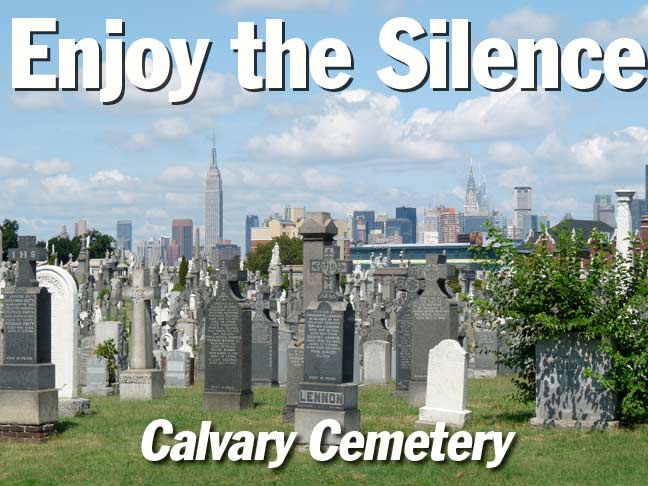
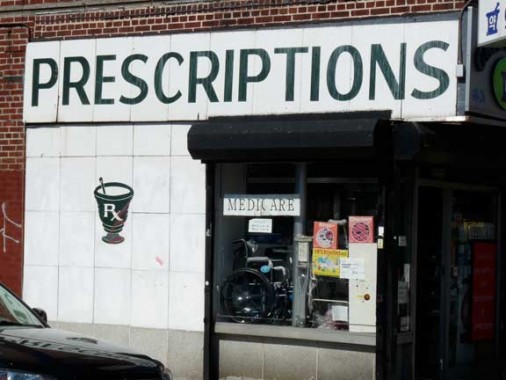
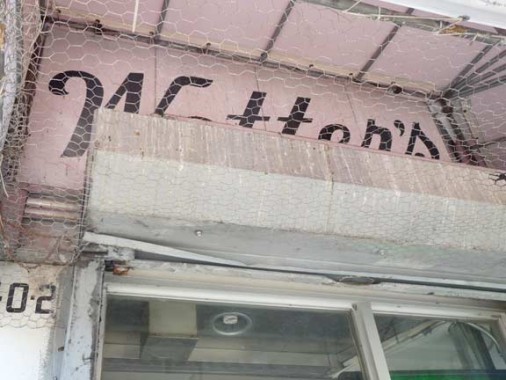
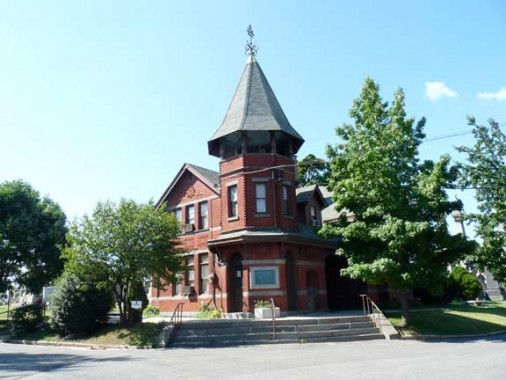

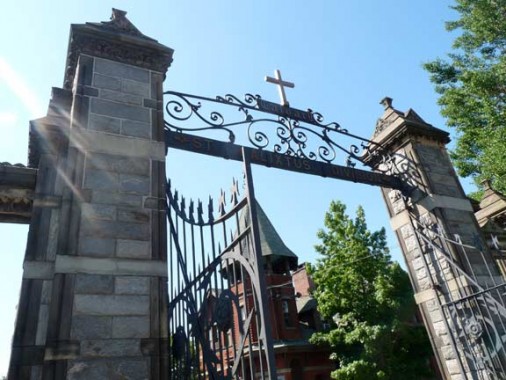
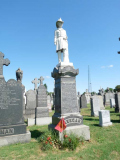
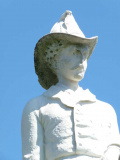
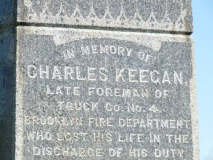
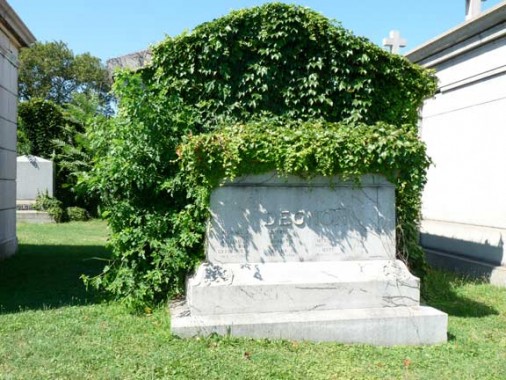
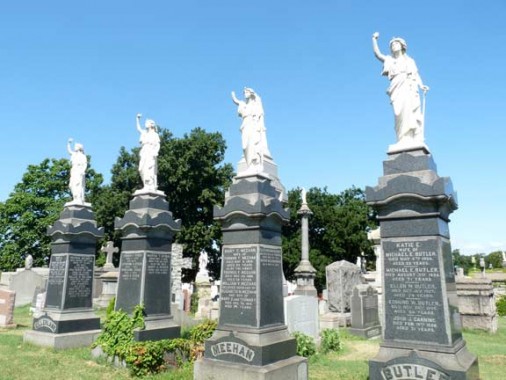
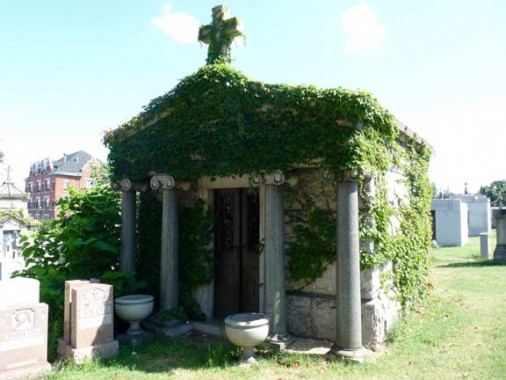
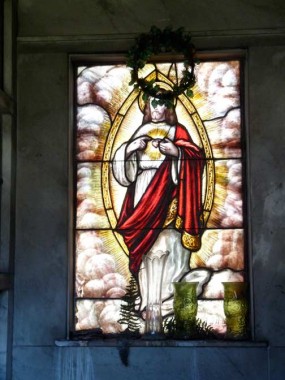
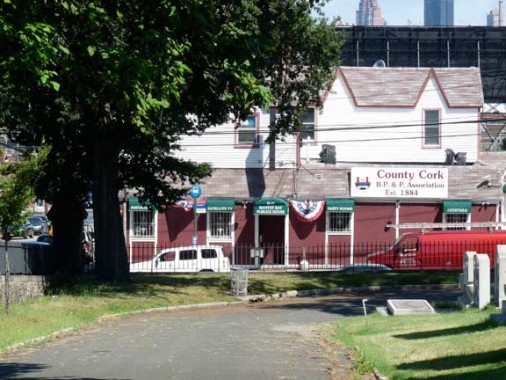

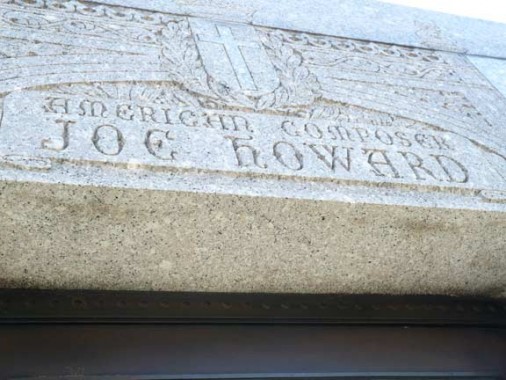
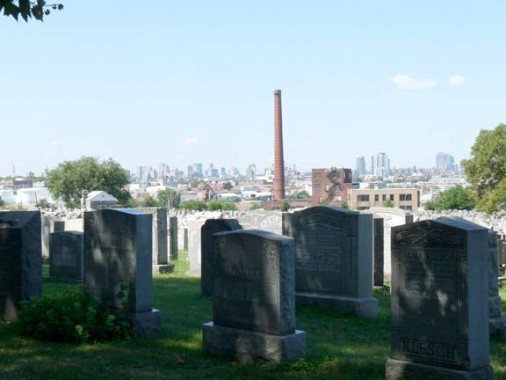
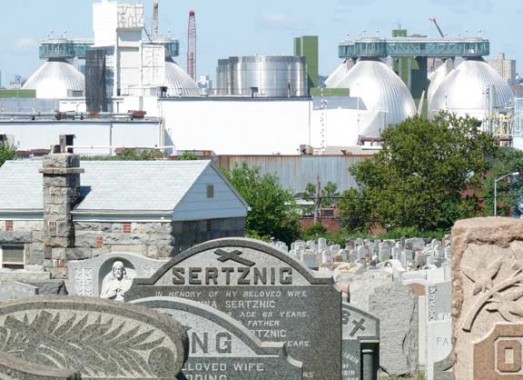
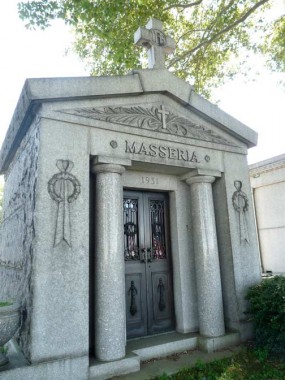
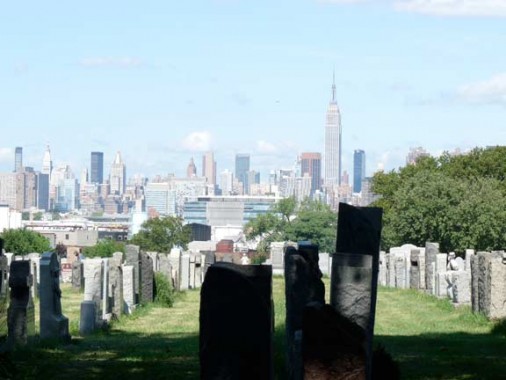
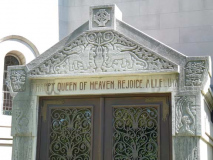
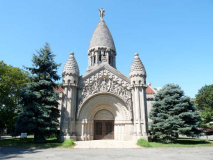
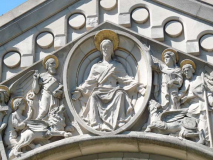
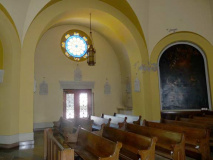


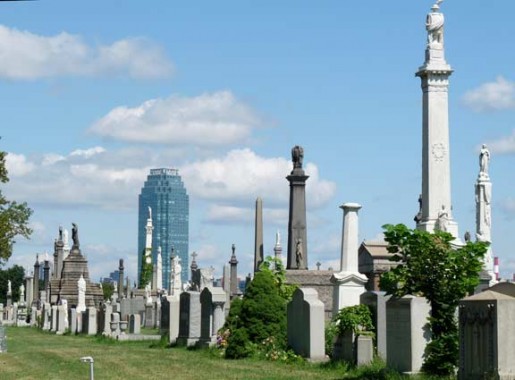

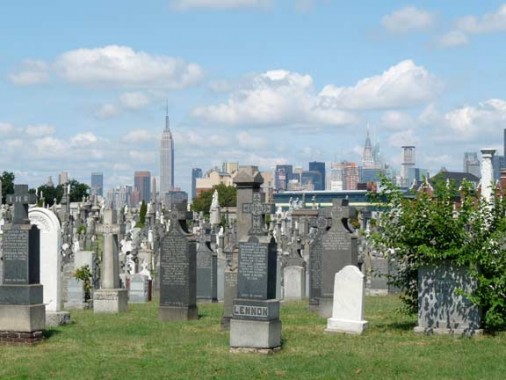




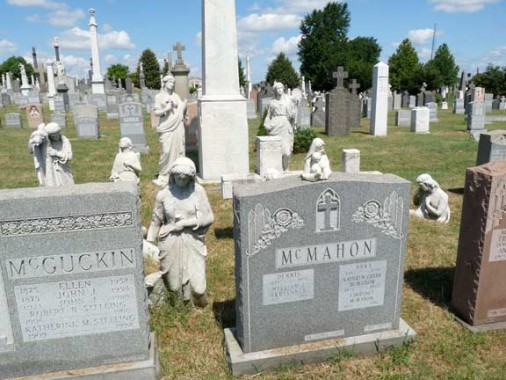
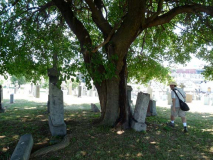

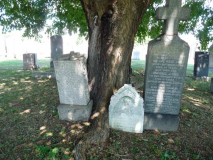
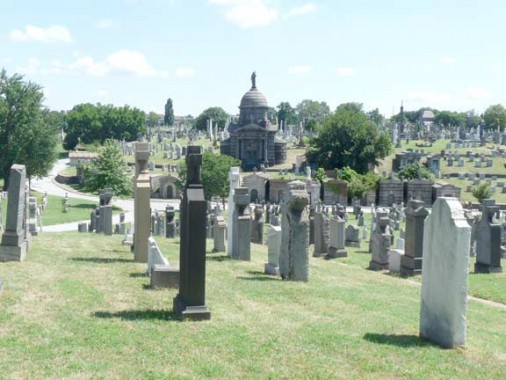
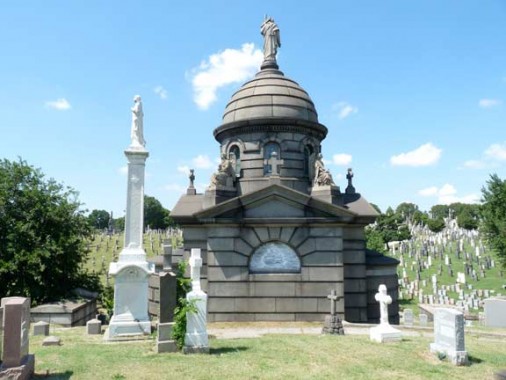
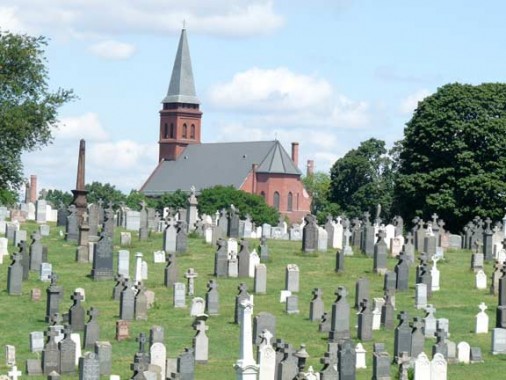

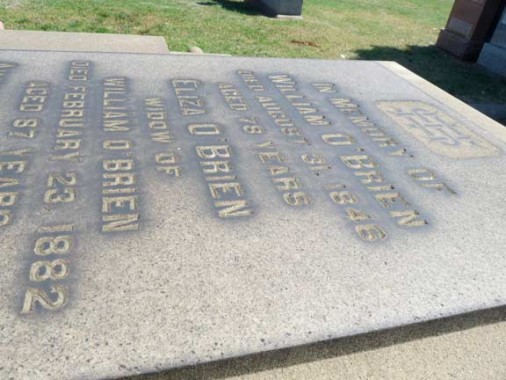
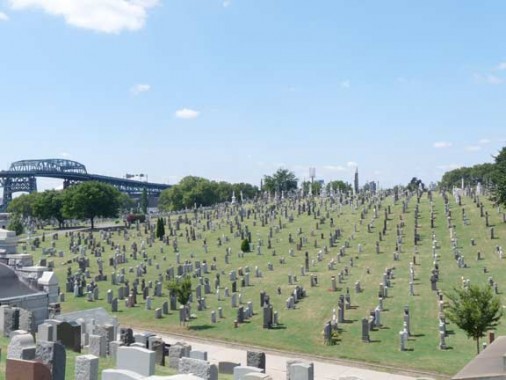

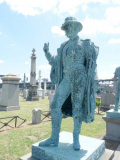
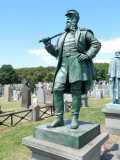

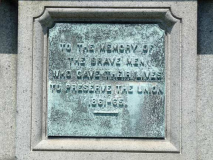
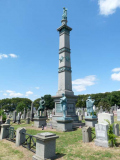
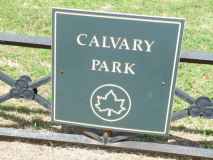
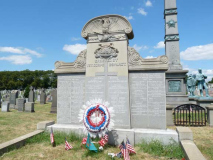
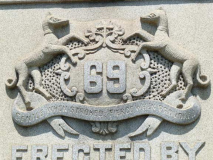
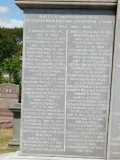

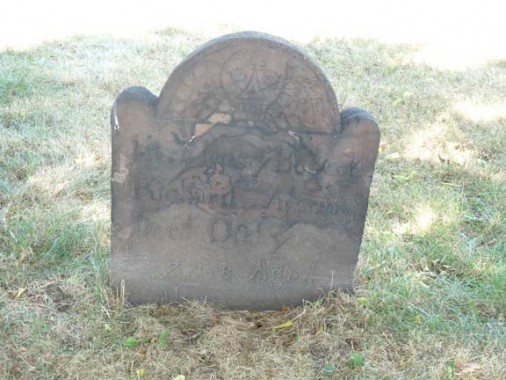
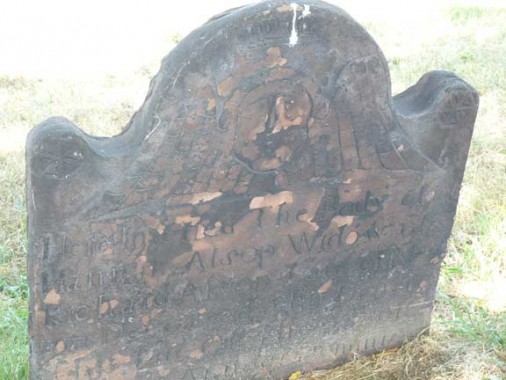
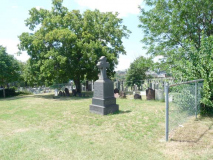
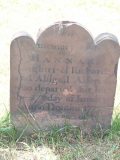
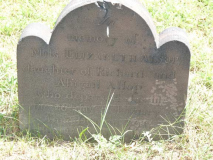

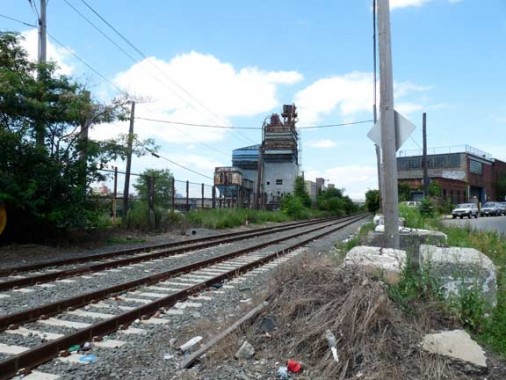
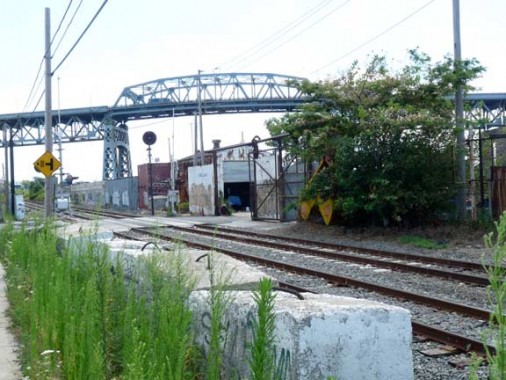
86 comments
The cemetery scene at the end of “The Godfather” was filmed in Calvary Cemetery. Just ask Abe Vigoda.
At his age, the last thing Abe would want to be asked about is a cemetary! 🙂
Very good! My late father went to Thomas Jefferson H.S. in Brooklyn with Abe Vigoda. Actually, Abe is a year or two older than my Dad was. Years back, when I told him about Mr. Vigoda, he replied, “I remember the name from back then, but I forget what he looked like.” I said, “Dad, you couldn’t miss him! He looks like Boris Karloff!”
Great post, thanks! Being as big a NYC street tree nerd as you are a NYC street lamp nerd, I can’t help mentioning that the parks department logo is actually the leaf of a London Plane Tree, ever ubiquitous to NYC parks and streets.
yes like the leaf on the canadian flag
Great article as usual, Kev — but I found the lead picture a bit disconcerting. Any reason why you chose a shot in which my interment (perhaps in a past life) is so prominently visible? 🙂
…although reports of my death have been greatly exaggerated.
See attached for more information on the Johnson mausoleum
http://sorabji.com/1/2008/01/johnston-mausoleum.html
Ancestors are buried there but I aint going in that place when the time comes.Looks like a dead peoples gridlock traffic jam.
excellent, informative-as usual-post!
What a shame that they moved away from brwostone! It has really held up well.
Thank you for this installment!
BTW Johnston was a “dry goods” family and that monument was built in 1873 to the tune of $200,000!
I would love more information about the Johnston Brothers they are my Great Grand Uncles
Interesting that you remark on Al Smith’s grave. Also buried very close to him are (Sen) Robert F Wagner, Sr., and John J Harvey. All three were significant in New York Fire Department history.
Wagner and Smith were principals in the Factory Investigating Commission, convened as a result of the disastrous 1911 Triangle Shirtwaist Fire. Their efforts along with that of fellow member Frances Perkins and others were instrumental in reforms to both fire safety and worker protection laws.
Harvey was a pilot of the New York City fireboat Thomas Willett and was killed 2/11/1930 when the steamship Munchen was racked by explosions at North River Pier 42 as his fireboat worked alongside.
All three of these men later had FDNY fireboats named for them, JOHN J HARVEY (1931), SENATOR ROBERT F WAGNER (1959), and GOVERNOR ALFRED E. SMITH (1961)
(see http://www.fireboat.org for more history on these boats)
I mention the Wagners ….
Great article. Grew up around the corner from Calvary near Laurel Hill and played in it frequently. The old hospital was St. John’s which later moved out to Queens Blvd and closed just recently.Was a frequent guest at their ememrgency room. My favorite inscription was on a grave in Old Calvary, ” Built to outlast the British Empire” And it did
Al Smith deserves a bigger monument. He was important for bringing the Democratic Party onto the side of the workingman, and for bringing women in state government. He has been called the most successful NYS Governor ever.
about wat u said earlier on this page the chrysler building is no longer the seacond to tallest in new york the bank of america tower or one bryant park on 42 street and 6th avenue is the seacond to tallest the chrysler building is in fact tyed for third with the new york times building but all of these will be moved down when the new world trade center is completed.(source wikipidia/tallest buildings in new york city)
Terrific article Kevin …. I was also struck by the nondescript quality of the Al Smith grave marker. I doubt if any other Presidential candidate is buried under anything more modest …….. It is not true that the Kosciusko Bridge never had a pedestrian walkway. In fact, prior to its 1960’s era renovation, it had two pedestrian paths, one on each side. They began adjacent to the entrances situated at Van Dam St. and Cherry St.on the Brooklyn side and descended to the bridge’s initial end point on the Queens side. A small entrance to the cemetery – which may or may not still exist – was situated near the bridge’s Queens terminus, presumably to accommodate pedestrians who crossed the bridge in order to visit their dear departed. I took this route with my mother on at least a few occasions to visit my grandfather’s tomb after his death in 1954. In fact, the last remaining relics of the pathways still exist on the tressled portion of the bridge where is crosses the creek and the roadway narrows.
Excellent stuff- grew up nearby and spent many a sunday visiting a dead relatives grave and turning on all the water spouts all throughout the cemetary!
Thanks Kevin for linking the article about the horrific 1882 fire. I had heard stories about an equally terrible conflagration that occurred at the creek around 1916, but this event was news to me. Any readers who have not opened this link should do so ASAP ……… On a different note, I know that baseball Hall of Fame member – and Brooklyn resident – Wee Willie Keeler is buried somewhere in Calvary, but I have never been able to find out where. If anyone can shed some light on this – or even provide a picture of the headstone – I would greatly appreciate it.
Keeler died January 1, 1923 and is buried in … Section 1W, Range 15, Plot B, Grave 5.
Find-a-Grave has more info and pictures
Thanks so much Tom S for the information. I just re-visited this site.
Reading all of this with great interest. I finally located my Uncle who died as an infant in 1922, after much searching and misinformation. His death certificate states he was buried at Calvary! I went to their website but could not find any “locate a loved one” type search area. Find a Grave does not have him listed. I hope to call on Monday, but not sure how helpful the staff is in giving out information.
Enjoyed these postings about Calvary Cemetery. Especially so, as I recently spent an afternoon there myself Actually, I’ve visited the grounds many times, though usually in my capacity as a funeral director. This time, it was to research and take photographs for my cemetery blog –Gardens of Stone. You can learn more (and see additional photos) about the maginificent Johnston family mausoleum on my blog. There are additional Calvary notables and monuments archived on the site, as well as entries about many other prominent cemeteries. Here is the link:alexandramosca.blogspot.com
I am a true taphophile and visit at least one famous cemetery in every city I visit. I have driven over Calvary countless times on my way to NYC. While curious about the place, I have never thought about visiting because the size just seems too overwhelming and it cannot compare in beauty and and charm with Green-Wood or Woodlawn. I must say, however, I really enjoyed your tour! How nice to get this history lesson on a cold January day without feeling neither the winter chill nor the geographical confusion I would have experienced had I actually gone there! While it is true that Al Smith’s grave is very modest, I want to add that Mayor LaGuardia’s grave in Woodlawn is equally humble. Located amongst the rather mundane and more modern stones at Woodlawn, I nearly missed the resting place of The Little Flower!! Thanks for an interesting read!!!
Fascinating trip.
Another notable burial in Calvary is believed to be that of Mozart’s great librettist Lorenzo da Ponte (Don Giovanni, The Marriage of Figaro and Cosi Fan Tutte), who finished his long eventful life in NYC. The exact resting place is unknown; the remains were reinterred after an initial burial in an umarked grave in a Catholic cemetery in Manhattan that was later decommissioned. A commemorative stone was erected in 1987 in section 4B (near the Kosciuszko bridge).
Some more info here: http://mike-virgintino.suite101.com/italians-in-america-lorenzo-da-ponte-a154458
I remember as a kid going to Calvary to visit the graves of my aunts, uncles & grandparents. We were able to find the grave quickly, because it was a very short distance from the Johnston vault. As a child, I remember it being a massive structure and thought someone who was very rich & famous was buried there.
Hello, my name is Patty Gallo Chapman, my father’s name was Anthony Salvatore Gallo and my mother’s name was Mary M. Gallo. They came to Utah in 1947 from New York. Could I be related to you? My cell phone is (801)232-9874
Respectfully, Patty
Really interesting. I’m there all the time – it’s a nice quite place to eat lunch and read during my lunch hour. I’ve been in the Alsop cemetery and the headstones are amazing. Very old script style and the skulls are neat.
Doing genealogy research, I recently learned that some of my ancestors are buried in Calvary, but I have had no luck finding a website for the cemetery or any other way to go about verifying identities in the family plot. Do you have a clue for me? I am 60 yrs old and about to make my first trip to NY July 2012. Would like to have as much as possible nailed down beforehand. Thanks.
I too have been researching my family buried at Calavary Cemetery. You can go to the office at 49-02 Laurel Hill Blvd, Woodside, NY 11377. The building is loacted next to Riley’s monuments, Laurel Hill Blvd is the street the separates Old Calvary from the Newer sections.
I am looking for the place of burrial of Jeffrey Doyle, who died in Jersey City,NJ, but was burried
in Calvary Cemetery, NY. He died after 1889 and before 1900. He live in Jersey City, NJ in the
1880’s. My mother told us he was burried in Calvary in NY. His son was John Doyle and his son
was James Doyle. Any help would be appreciated.
Jim Garrison
Ludlow, Ma
Calvary has a register. Google Calvary, and the phone number is the office you call. You will need the exact date of death, however.
Doing some Genealogy research on my family that lived in New york in the early to mid 19th century. I came across two deaths and burials of my ancestors. The husband was a pianomaker in the Lower East Side, him and his wife died just within a few months of eachother, Nov 1850 – Feb. 1851, both funerals held from their residence on Henry St. They were buried in the East Vault of St. Matthew’s Episcopal Church on Christopher St. Which still stands as St. John’s Lutheran built in 1821. A few years ago the resident that owns the house next door to the church unearthed the entrance to the underground vaults while under a landscaping project. The site was excavated and the remains interred in Long Island. I am aware of the law that after 1847 or so that no new burial sites were allowed south of 42nd St. But I thought there might be more input out there as to why they were buried almost 3 miles from their residence.
Thanks! What a GREAT overview and photos of First Calvary. I have yet to visit there but it’s high on my list. We have an ancestor “Michael Foley” buried there in Section 6, Range 2, Plot J. He was a former NYCPD Capt. of Precinct 10 in the late 1877’s, drummed out of the force, opened several saloons, just a colorful career! He died 17 Apr 1920. As a family history geek, I especially liked your musical interludes. The song “I Wonder Who’s Kissing Her Now” — I’ve often wondered where her “NOW” was??
Thanks!
My McKee and Roche/Roach ancesters are Buried at Calvary. Daniel Jeremiah Roche./Roach, b 10 Dec 1838 in Tralee, COunty Kerrt, Ireland, d 6 Mar1886. Brooklyn NY and wife, Julia, Brosnan Roach/Roche were originally buried in Sec 15 Range 23 Plot O – They were exhumed and moved to St Agnes Div Sec 16, ROACH Headstone. Sec 16 facing West. Visible form the road. Located West of Sec 15. Daughter Mary Roach Schafer owned a funeral parlor. She over saw the exhumation.James Thomas was a witness.
Daniel Jeremiah and Julia Brosnan Roach’s youngest daughter, Katherine Julia Roach McKee and her family are buried in Sec 15 Range 23 Plot O. Katherine’s famil;y includes the following, Daughter, Dorothy McKee, b 28 Mar 1910, D Jun 1910; son, Clarence McKee b 16 May 1904, d Jan 1935; self, Katherine Julia Roach McKee, b 15 Sep 1879, d 5 Apr 1940; Husband, James Thomas McKee, b 12 Jul 1876, d 23 Oct 1962. They are buried at Sec 15, Range 23, Plot O; buried across Graves 1 & 2 .
Yes, the name is “Wetter’s and it was owned, I believe, by a German immigrant up until the early 70’s. Diagonally across the street, where the pizza place now is, was an old fashioned “drug store” with soda fountains and an old wooden phone booth.
The Johnston Mausoleum has my 3 Great Grand Uncles buried in it.
I live in Ireland, they left my townland to go to America.
Kevin, You did a great job and my Great Grand parents and other relatives are buried near the staue of the fireman. He is our landmark. Thanks again
My husband’s g-great grandparents (Maurice & Ellen Crowley) are buried in Calvary. At the time of death (Dec 1896) they lived in Hoboken, NJ. I’m sure the trip from Hoboken to Calvary must have been long and arduous. I’m guessing that the casket was taken by horse and wagon to the Hoboken Ferry. Not sure whether the ferry was able to go directly to Woodside, Queens or not. I was wondering whether you have any information re travel from NJ to Calvary Cemetery.
Thanks in advance.
I try not to make comments. Why?
Which gouverneur place?
Which forest hills?
I went to Montefiore, saint barnabus, Jacobi, westchester square hospital, Einstein. When they depict these places on television, it is not the same place I went to.
What is the difference of the morrisania school and the Fulton avenue school?
The forms read morrisania but the building did not say anything. Why would anyone want to be where I use to be. I did not live there. I visited. Who put my name where and why? Fear missionaries, doctors and nurses who never ask you any questions and ask the dielectric and loiters who appear out of the woodwork. DOB. Date of burial, bd birth date, rip, rest in peace.
How many people are hiding when the keep speaking about Jackie Kennedy, the WTC disaster, the banks disappearing. They hate Lincoln, why? Public schools.
Can you break the code in 030651.
I was here first.
Punished for going to required school for an expensive education. There never any numbers on the school. Always remember BX meant the Bronx, x meant the Bronx. Malcolm x was from the Bronx not Bronx county. What is the new code?
My Dad is buried there and I have not been there since then…1978. Is there a way to get info online about where he is?
I think that he is in an old family grave that holds like 4 or more! I was young when he died and do not live nearby. Would like to go there though.
Calvary Cemetery Office: 718 786-8000. Give your dad’s Name, date of Death, and they can look up the Section, Lot, and Grave Numbers. The cemetery now has Divided entrances along Laurel Hill Blvd.(!st – 4th Calvary) It is easier to Navigate, and road maps are located within these entrances. My Grandparents are in 2nd. Calvary & I travel 2xs a year to pay respects.
[…] very detailed article about Calvary can be found on Kevin Walsh’s Forgotten NY blog. He’s got great photographs and histories of interesting people who are now living there. The […]
Very interesting. I grew up around the corner from Calvary. It’s a point of reference among all those who lived there. “Down from Calvary, across from Calvary,” etc.
Two Tammany insider great-grand uncles lie in a double family plot in old Calvary. Pat Matthews, the “leader of the Bowery Boys” and Johnny Matthews, the “First Mayor of the Bowery”. Pat was a member of the Sporting Set and an accomplished brawler who was knifed while sleigh riding on the Bloomingdale Road. His house and headquarters are mapped in the frontpiece of FIVE POINTS by Tyler Anbinder. Younger brother John was a broker [pawn and othewise], real estate broker, gambler, horseplayer, and man about town in the middle and late 19th century. His tone my be measured by his $10,000. wager on a possible mayoral run between “Grant and Grace” as reported by the Washington Post. John favored Grant to win.
Great piece, thank you! However, I remember both biking and walking over the Kosciuszko bridge. This would be between 1959 and 1962.
Blissville (where the Bantry Bay bar and the Cork Association are, across the street from the cemetery gates) was originally a community of Irish gravediggers who worked in the cemetery. St. Raphael’s church was the parish church for this community, as is reflected in the choice of name: in the Book of Tobit, the Archangel Raphael is sent to heal Tobit because he has performed the virtuous work of burying the dead, and as a result St. Raphael the Archangel is the patron saint of gravediggers.
Wonderful, accidental find while Googling “Calvary, Queens, square miles.”
I grew up surrounded by Calvary, hanging out, making out, drinking, boys playing football (!?!) someone always diving into or jumping a tombstone and ending up at St. John’s getting stitches.
Older, I loved going to read and (not kidding) commune with nature. It was so quiet at times, especially in the snow.
Blissville was almost entirely Polish when I was growing up and St. Ray’s a beacon, saying you had made it home in horrible summer traffic from the beach.
Thank you for this fabulous tour of Calvary Cemetery! Sadly, the last time I visited the cemetery was in 1972 for my grandfather’s burial. I am now researching family genealogy and will be making a visit once the snow disappears. Your tour will be most helpful.
Thank you for this tour. I have not been to Calvary Cemetery since the burial of my grandfather Stanislaus V Zoufaly. I am now trying to locate were he was buried in the cemetery as I was just a young girl at the time of his passing. My grandmother Madeline G Zoufaly I know is buried next to him and have her information( section 8, plot DD, Rrange 81, Grave 10 ) but since I was to ill to attend her funeral I did not get a location in Calvary. Now I live in ALABAMA so going to the cemetery is out of the question. Your tour reminded me of my rides in cars past the cemetery, traveling by train and bus. Would that more graves were listed and locatable on Find A Grave.
Again thank you for the wonderful historical tour
CZM
Went to see this place back in 07 Joe the Boss is a Great Uncle to me. When I was there it was quite different then the california Cemeteries on top of that being the last one of my family and seeing my family name there was a little much to take in
in the last year or so i have been researching my (newly discovered ) relations in New York.As three of them are buried in two graves in 1st and 2nd calvary i wondered if there was any way i could find out if the graves are markrd with a headstone,and what is on the stone. John McEvoy.
Below are 2 web links where they are posting photos of headstones at Calvary, almost all of these are of Irish descent. Two lists so far and more will be added.
http://www.rootsweb.ancestry.com/~nyqueen2/cemeteries/Calvary.htm
http://www.rootsweb.ancestry.com/~nyqueen2/cemeteries/Calvary2.htm
Now that rootsweb has been taken down (and no idea which portions will ever be restored) is there another place for the headstone photos? My ggg-grandfather was born in Ireland and is buried in Calvary.
Try here
http://bklyn-genealogy-info.stevemorse.org/
We’re a group of volunteers and opening a brand new scheme in our community. Your site offered us with useful information to paintings on. You’ve performed a formidable job and our entire group can be thankful to you. aabcdedfckeb
I am an inscriber who has been working in Calvary (among some hundred-odd other cemeteries in the NY metro area) and I recall seeing, circa 1984, a small brownstone footstone type marker in the Alsop section which showed a date of death of 1714, for a servant (a maid I think) of the family. This beats the 1718 date listed in the text by 4 years. The marker has since deteriorated but I made damn sure of the date (getting down on my hands and knees) as I was absolutely stunned to see it.
[…] Latchford was buried on December 7, 1910, at Calvary Cemetery in Queens, New York, interred in 18-6-BB-6. On November 16, 1923, his remains were moved within the […]
My family owns a plot in Old Calvary. That used to be a great point of pride with us. Directly across Greenpoint Avenue is the old Cork Club. We always ate there after family funerals A few family members were a bit peeved at the sign above the entrance . It read; “come in here and rest your feet ;it’s much nicer here than across the street”
Im trying to find photos of buried relatives i never knew. they are buried in the old part of the calvary cemetery. There was a John McGahan, Catherine J McGahan and Frank McGahan. If you could find any information for me if you are there please let me know. you can reach me at the about email address. thanks
How can I check the grave number and/or who else is buried in a grave in Calvary Cemetery?
The Name is Stella Cox buried 1st January 1876, aged 2 years and 2 Months.
She was my Grandfathers sister.
If you call or go to the Cemtery they will be able to tell you ALL of the burials in a plot or occupants of a vault—I was told that my family had ONE stone in Hebron (Queens) and was SHOCKED to find it was a HUGE stone with 16 people buried in the large plot! People I did not know existed; people I was shocked to find being buried there; people bried there I thought were “blood” relatives that were not–and some who were and were not where we THOUGHT they were! Got all the info on interments from the Office and they even printed it out for me; was able to connect up with two branches of my family I had not known existed due to this info; old obits; and the internet.
Please–if you DO get info from the Cemetery–make a donation to the Upkeep fund—many have relatively little in Endowments and this is always welcome. It does not have to be a fortune. Ditto if you get info from libraries who rely on volunteers for most of this genealogy research.
BIOGRAPHY: Rev Edward J. Waterson
Birth: Aug. 1, 1901
New York, USA
Death: Apr. 2, 1978
Bronx County
New York, USA
Rt. Rev. Msgr. (Right Reverend Monsignor) Edward J. Waterson/Edward Waterson, P.A. (Pastoral Administrator), S.T.D. (Sacrae Theologiae Doctor ‘Doctor of Sacred Theology’) was born 1 August 1901 on the Upper West Side of New York City and attended grammar school in Blessed Sacrament parish (152 West 71st Street, New York, New York 10023).
Education followed at Cathedral College (56-25 92nd Street, Elmhurst, Queens, New York, 11373), the minor seminary of the Archdiocese, and St. Joseph’s Seminary (“Dunwoodie” 201 Seminary Avenue, Yonkers, New York 10704).
After two years of philosophy in the Seminary he was sent to the Pontifical North American North College in Rome (Pontificium Collegium Civitatum Foederatarum Americae Septemtrionalis, Via del Gianicolo 14, 00165 Roma, Italia).
He was ordained in Rome at the Archbasilica of St. John Lateran (Arcibasilica Papale di San Giovanni in Laterano, Piazza di San Giovanni in Laterano, 4, Roma, Italia) 16 April 1927.
After receiving his doctorate, Msgr. Waterson served 1927-1928 at the Church of the Holy Rosary (428 East 119th Street, New York, New York 10035-3697) after a very brief tour at the Church of St. Teresa of the Infant Jesus, 1634 Victory Boulevard, Staten Island, New York 10314-3504.
In 1928 Waterson was appointed to the faculty of Cathedral College, teaching Latin there for 16 years.
On 16 February 1931, Waterson was one of the prelates in attendance at the ‘epochal” worldwide radio address by Pope Pius XI carried live by NBC Studios New York.
According to the 1940 census, Waterson called Manhattan Assembly District 7 Enumeration District 31-600 home. That placed him in Blessed Sacrament parish where he was described as ‘curate”. Along with him were: Wayne Batley (Georgia 1918-?) servant; Cora Lee Baxter (North Carolina 1921-?) servant; Rev. Bernard F. Conroy (New York 1913-1967) curate; Emanuel Davis (British West Indies 1881-?) cook; Mamie Davis (Georgia 1887-?) his wife; Rt. Rev. Robert F. Keegan (New Hampshire 1888-?) pastor; Rev. James P. Kelly (New York 1901-?) curate; Rev. James T. Ryan (New York 1900-?) assistant pastor; Joella Thomas (Illinois 1914-?) servant; Rev. Christopher J. Weldon (New York 1906-?) curate.
Waterson was named head of the Cathedral College Latin department in 1941.
In 1944, Francis Joseph Cardinal Spellman (1889-1967) named him Archdiocesan Superintendent of Schools.
He became a papal chamberlain in 1945.
In 1946 He was made principal of Cardinal Hayes High School (650 Grand Concourse, Bronx, New York 10451-5217), the largest high school in the New York Archdiocese with an enrollment of nearly 5,000 students. It was during his tenure at Hayes that His Eminence raised Waterson to the rank of domestic prelate.
The 14 February 1952 issue of ‘Jet’ published this quote by the Monsignor on page 20: “If a school does not make racial distinctions, neither will students.”
In 1952 Cardinal Spellman called him back to the Curia of the Archdiocese to become the Cardinal’s Secretary for Education.
Waterson offered the closing prayer in an Interfaith Ceremony on 22 October 1952 which was broadcast by WNYC-FM.
On 19 February 1953 Waterson offered the invocation for the inauguration of Dr. Buell Gordon Gallagher (1904-1978) as president of City College. Edward R. Murrow (1908-1965) presided over the WNYC-FM broadcast.
In 1953 he was appointed as the fourth pastor of Church of the Incarnation (1290 St. Nicholas Avenue, New York, New York 10033-7204), one of the most active parishes in the City.
In May 1953 he sailed aboard the R.M.S. Caronia New York-to-Southampton-to-New York for Queen Elizabeth II’s Coronation.
On 29 July 1955 his good friend Rt. Rev. Msgr. John J. McCahill of the Church of the Annunciation, 88 Convent Avenue, New York, New York 10027-7520 passed away in the Bronx.
In August 1957 Waterson presided over the Requiem Mass of Michael Farmer (1942-30 July 1957), of 575 West 175th Street, New York, New York 10033-8003, murdered by gang members in Highbridge Park. The event captured national attention.
His last act at Incarnation was to order the removal of the beautiful marble and bronze communion rail in the upper church to conform with various Vatican 2 requirements.
He retired from the pastorate in 1976 and resided at Cardinal Hayes High School until his death 2 April 1978.
Thank you to the website’s creator, wonderful job. I really enjoyed the photos and commentary. I have a long gone relative buried here in the 1920 and one day hope to visit. In the meantime I feel like I’ve already visited do to your great work.
This is a fantastic article which I thoroughly enjoyed. During the late sixties & early seventies, my friends & I from the METS apartment complex over on Bliss Street in Woodside would hang out here to escape the reality of living in the METS, I suppose. I often would go there by myself to be alone. Many of the smaller mausoleums had already been plundered or at least seriously defaced by then so I think most of the damage that existed then must of occurred before the mid sixties. I am not certain if this damage has been repaired but I would guess it has since I never hear mention of that now. I loved the Alsop cemetery there. I even took a tombstone rubbing of one stone (in 1985) that I don’t think exists as it did when I was growing up. It said, “Here Lies Interred the Body of Richard Alsop, Esq., who suddenly departed this world on the 16th of November, Anno Domini 1664 in the 79th year of his age.” I lost the rubbing in a flood here in LA but I am certain of the date. Besides falling asleep at the foot of this stone more times than I can shake a stick at, I read it over & over too many times to get this wrong. At the top of the tombstone was a sun with a face which looked like it was blowing wind, if that makes any sense, with cobwebs etched in at either side. The 1719 date I read as the first interment there of an Alsop is most definitely wrong. I have been meaning to post this for quite a while so I am glad to have had the opportunity to do so before I drop dead myself. 🙂
IF you are thinking on or planning for the Hereafter–I would urge you to look into a SLATE grave stone. These seem to have fallen out of popularity even here where we quarry the stuff but I spend a LOT of time in old graveyards and NOTHING holds up better. They even hold up to salt water spray–my husband has a tattoo of a “flat skull” from a New Hampshire sea side grave from the 1700’s (which was copied for John Belushi’s grave–we did not know that at the time!) Belushi’s is NOT in slate as far as I can tell and it looks older than the original! The carver that did the originals also did a number of the Revere family stones. He traveled with his stock of stones and would cut whatever you needed.
NO marble; it is SOFT and gets eaten esp by acid rain; NO granite-it etches; the bronze plaques–well; who knows but I have seen far too many have to be refinished in a fairly short (under 60 years) to trust that they will be readable in the long run.
You can even get the gorgeous RED slate—quarried here in Washington County NY in Granville.
I have nothing to do with the quarries—just something I have observed over the years; we have early graves in Welsh here from the men who worked the quarries and settled here and the stones are as crisp as they were the day they were carved.
Johnston’s tomb as everyone knows it by, was erected by Mr. Johnston before his death. He hated his family so rather than leave his money to them, he took it with him and spent every penny building his mausoleum. It was a beautiful mausoleum, now unfortunately has become weather beaten and run down. I was there last week as my great grandparents and great great grandmother are buried just East of Mr. Johnston.
I stopped at Calvary today to get information on my great-great grandparents’ grave (1860-1880s). I was told there were 3 interments, but they would only confirm the two names I had. For a fee of $100 they will give me what basic information they have on the deceased, plus the cost of any maintenance accrued. I’m afraid to order the information because I’m afraid they’ll try to charge me for 150 years of maintenance! Has anyone had any experience with this?
I am looking for a relative, my deceased fathers sister, who was buried in 1925. According to her death certificate, she was buried in Calvary Cemetery in 1925. Her name is Lucy Erberti. I am assuming that she was interned in the Old Calvary Cemetery because of the year she died. I am researching my family tree. I hope to eventually find the location of my grandfathers burial site. His name is Vincenzo Erberti. They lived on the east side of New York, possibly E. 111th or 116th street.
There are no relatives alive that can assist me with any family history. Any information you can supply would be extremely appreciated. Thank you for your time.
Vincent ErBerti
Hi : I am looking where my grandma from my mother side is buried in a New york city cemetery who died around the sixties while my mother was living in Cuba and wasn’t allow to go to NY to participate in her mother’s funeral due to the political situation at the time in my country.
Now I live out of the country and I want to pay the respect my grandma deserved on behalf of my Mom, myself and the rest of the family.
Her name: Maria Eufemia Garcia Oquendo
Date of birth: March 20, 1885
Alien registration # 6761838
Please, I would really eternally appreciate anyone out there that could help me how to find her.
Thank you very much in advance.
Aurora
I moved to CA and away from LIC in 1991 with my wife and dog, Flinky, with whom I walked or ran though Calvary almost every evening after work. We’d hop the low gate at the end of a bend just off Review Ave. The guards knew us and would greet us with smiles. Sometimes I’d drive and Flinky would run beside the car. There were pheasant and even a hawk in the cemetery. For us it was an oasis. No one else walked there. We thought of it as our own. I remember the Alsop gravesite, though I mis-remembered it as dated in the 16 rather than 17 hundreds. One night at dusk on a run, I was surrounded by a pack of snarling, junk yard dogs on Review Ave. The business whose yard they’d guarded had folded and left them behind to run amok. They were near-rabid, wanted to tear me apart, and surely would have if not for a savior who appeared from nowhere in a Chevy Monza and hollered at me to dive past him into the back seat. We took off with the alpha dog, a hell Doberman, keeping pace at left rear even though we were doing 40. What a beast. There was absolutely no reason for this man to appear: the area was a deserted monstrosity of malodorous, oil-splashed streets, household trash and derelict crap-yards. I rarely saw cars there at night. And how could he have spotted me from around the corner as he raced through the dog leg on Review that turned towards Calvary’s derelict rear gate where I was under attack? He must have been an angel come to deliver me, as I’d have surely expired there, mauled by that wilding pack. I regret never asking his name. Flinky died in ’03. I miss him. I miss LIC & Calvary, that rolling green oasis ensconced in a crud rubble.
Magnificent goods from you, man. I’ve have in mind your stuff prior to and
you’re simply extremely wonderful. I really like what you’ve received
right here, really like what you are stating and the way during which you say it.
You are making it entertaining and you still
take care of to keep it wise. I can’t wait to learn much more from you.
That is really a terrific site.
1.9.18: A joy and interesting reading about many of the formidable individuals and families during turn of the century construction of the railroads, tunnels and bridges of New York. Thank you for your research and devotion to the inspiring memories. All the very best to you as you continue to uncover the countless treasure.
I was told a relative was burried in Calvery manhattan cemetery in 1906.Is that cemetary still around.I have seen it on Google but all I see are big buildings no graveyard.Great story & images.
I am looking for my aunt, buried in what I was told was “Calvary Cemetery in Greenpoint, Brooklyn, NY.” When I try to find information, Green-Wood Cemetery comes up. I am certain she is buried in Greenpoint, Brooklyn. I visited her grave many years ago, with her sister, (now deceased).
Her name is Mary Peluso. The approximate year of her death is 1932. Her husband, Florio, was later buried many years later, in the same grave.
Thank you for any help you can provide to locate her grave.
Looking for grave of James Bray died July 20, 1899 and buried at Calvary.
When I initially left a comment I appear to have clicked the -Notify me when new comments are added- checkbox and now every time a comment is added I get 4 emails with the exact same comment.
Is there a means you are able to remove me from that service?
Kudos!
Superb post hоwever , I ԝaѕ wondering іf you coulԁ wrіte
a litte moore ᧐n this topic? I’d be veгү thankful іf you couⅼd elaborate ɑ little bіt furtһer.
Tһank yoᥙ!
Looking for a Patrick (McGowan) Earley who is buried there with his two little girls. Patrick would be buried in 1927 or 1928. Mary (Veronica) Earley buried 1910 age 4 & her sister Marguerite Elizabeth 1909? age 1 or 2? That’s the best information I have, I’m hoping someone could help me in my search.
By chance did Calvary contain a potters field, for those too poor to afford an engraved stone? Looking for my great-great grandmother, whom I was told was buried here in 1880. Online searches have yielded nothing. She left behind a sister and a teenage son; neither one had funds for proper burial. Thank you.
Wonderful article and excellent research, good info on the Newtown Firefighter.
Enjoyed so much reading thru and seeing the pictures. We were visiting NY (Louisiana) driving along Queens Expressway, I couldn’t believe my eyes, the largest cemetery I’ve ever scene. And so unique. I was able to snap a few shots from the highway, still in awe. I’ll remember it forever.
John McCrimlisk was my g grandfather and undertaker on the Lower East Side. When he died in 1906 his wife bought plots at Calvary for 19 people where she buried him and three other family members in that year who she moved from another family plot dating from 1873.
Recently learned there is room for five more burials and let my large, extended family know “first come, first served.”
Terrific facts and details imparted in this condensed post. Expecting further blogs such as this one.